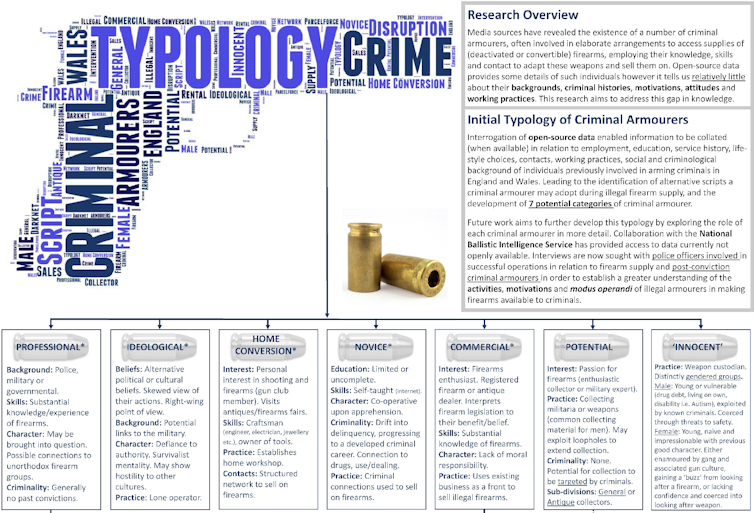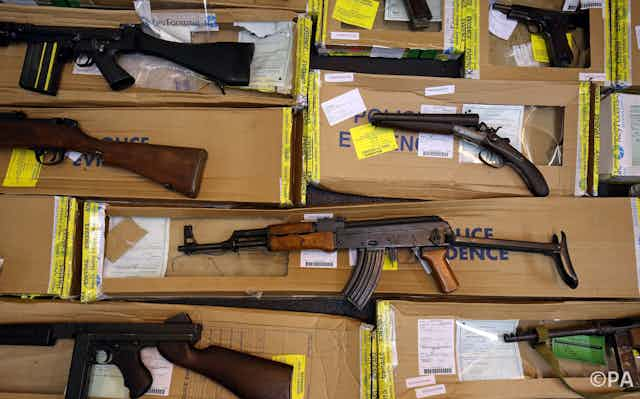How it is possible to get hold of weapons in Britain despite tough laws that restrict their ownership and use? This strict firearm legislation, enacted chiefly through the Firearms Act 1968 and amendments following the 1987 Hungerford mass shooting and 1996 Dunblane mass shoting, has reduced the number of purpose-made firearms in circulation. This has contributed to the number of firearms offences (including those using airguns and air rifles) falling from a high of 24,094 in 2004 to 7,866 in 2015.
A closer look at recent statistics shows that more than half the 7,866 offences involved unidentified, unknown, imitation, reactivated or other sorts of firearms. These type of weapons are often referred to as “junk guns” due to them being unreliable, underpowered, less robust, fairly inaccurate and likely to misfire. But this suggests that although the availability of high-quality firearms may have fallen, the demand for weapons remains.
This demand has driven criminals to be resourceful in identifying alternative sources of firearms. There are growing concerns about how they could acquire instructions online on how to build a home-made gun, or even 3D-print a functioning pistol. But what other alternative sources are criminals accessing in order to bypass strict laws?
How useless guns are made dangerous
Deactivated firearms (real firearms that have been altered so they can no longer fire projectiles) and replica firearms (anything that has the appearance of a real firearm, but isn’t) can be bought legally without a firearms license. With minimal tools, space and skills, criminals can convert or reactivate these types of weapons to enable them to fire live ammunition.
An alarming example is the conversions carried out by Grant Wilkinson, who changed legally-bought replica MAC-10 machine guns in a garden shed using only a lathe, metal cutters and drill bits purchased on eBay. His conversions have been linked to nine killings including the murder of PC Sharon Beshenivsky, who was killed during an armed robbery in Bradford in 2005.
Others have also been involved in manufacturing firearms and ammunition, for which there are a number of manuals and munitions handbooks known to be available – including some with official military origins. In 2013, Thomas Keatley was convicted of a number of firearm offences, including the manufacture of a fully improvised handgun in his garage workshop. Keatley had bought the majority of the items required online from the US and the UK, and had downloaded guides from the internet on how to make handguns and even automatic machine guns.
Also problematic are the many antique weapons, such as muskets or flintlock pistols from previous centuries, or even more recent early 20th-century weapons, which can be purchased without a firearms license. The definition of an antique weapon is not clearly spelled out in legislation. Instead it is based on a number of factors that include the weapon’s age and its calibre and if that makes it obsolete or impossible to find suitable ammunition. This means it has been possible for criminals to legally purchase a fully serviceable and potentially lethal firearm, albeit aged, and adapt ammunition to fire from it. This is a potential loophole that has been identified and discussed in a recent Law Commission report on firearms in the UK.

Criminal armourers
In my research I have studied the role of those individuals who use these avenues to supply firearms to criminals. I have identified seven potential categories of armourer to reflect different roles, skills, knowledge and potential motivations. Working with the National Ballistics Intelligence Service we’re developing our understanding of illegal firearm supply and the people involved, in order to identify a greater range of points at which police intervention could disrupt the supply network.
UK police recently made what was the largest ever UK gun smuggling bust with the interception of 22 Kalashnikov-style assault rifles and nine machine guns that had been brought from France in a boat that docked at a marina in Kent. These guns were deactivated weapons legally bought from a firm in Slovakia – the same source as the weapons used in the Charlie Hebdo and Kosher supermarket attacks in January 2015 – and then reactivated by armourers. The trade across Europe’s porous borders remains a problem for European police forces.
New supply routes continue to develop – firearms can be bought online through anonymous shopping sites on the darknet. Weapons can then be sent to the UK via standard post or through fast courier services, sometimes broken down into components to avoid detection and then reassembled for use.
Without a doubt, so long as there remains a demand for firearms in Britain, the criminal underworld will use all its ingenuity to meet that demand and continued research into their methods and the vigilance of police forces will be required to keep them out.

